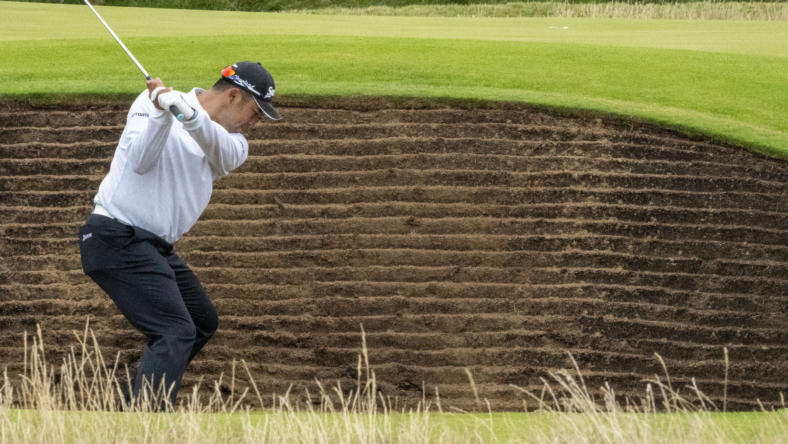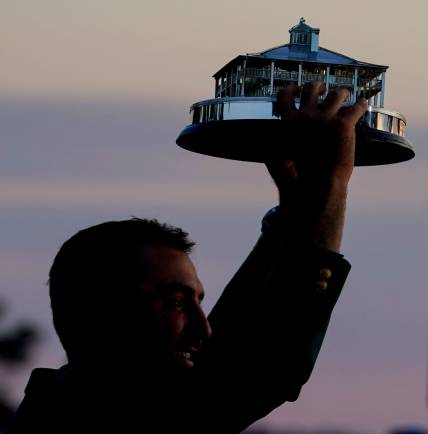On Thursday, the final major tournament of the year, the 151st Open Championship tees off at Royal Liverpool Golf Club Hoylake in Wirral, England.
The Open Championship has been played a dozen times at Royal Liverpool and some of the game’s best of their generation, both past and present have won on this course.
One of those players to have won the Open Championship at Royal Liverpool is in the field this week. That is Rory McIlroy, who won the Open Championship at Royal Liverpool in 2014 by two strokes over Rickie Fowler and Sergio Garcia.
As a result of winning last time at Royal Liverpool nine years ago, McIlroy is the favorite to win with +800 odds, according to Vegas Insider.
With the victory, it would give McIlroy his fifth career major win and first since that 2014 Open Championship.
Since the last edition of the Open Championship, the course will be different from new tee boxes, holes in a different order, and new holes.
Like the Masters, every hole has a name with some connection.
Here is the course preview with the difficulty of each hole from toughest to easiest at Royal Liverpool for the 2023 Open Championship.
Also read: 10 best performances in Open Championship history

1. #10 Far, Par 4
Usually, the first hole on the back nine is a par-5 for the members, but for the professionals this week, it plays as a long par-4. There are mounds about 350 yards from the tee that practically split the fairway, which sets up unusual lies. In addition, the mounds a raised, making the second shot blind. Players will be lucky to get birdies and par is definitely your friend on this hole.
2. #14 Hilbre, Par 4
There is another difficult par-4 early on the back nine with a dogleg left. There are bunkers on each side of the fairway to challenge the hitters that want to shorten the hole as much as they can. However, go left and miss the bunkers in the rough, that shot requires hitting over two pot bunkers to the green.
It is best to miss the approach left in order to avoid the ball running off to the right in a challenging but great Open Championship hole to watch this week.
3. #16 Lake, Par 4

With two pot bunkers on the left and one on the right, players might play below the sand pits and play a long approach shot in order to play for par as four bunkers surround the green. If wind plays into the players, this is a challenging par-4 heading into the final stretch of action.
4. #7 Telegraph, Par 4
After a stretch of three scorable holes, the seventh makes a player remember how difficult an Open Championship course is. And it starts with a tee shot that needs to be carried around 260 yards. The uniqueness of the hole makes the seventh more difficult, based on the angle players have to the green.
Hit it on the left and players have to hit over two pot bunkers. Hit the shot to the right and players are feeling better that they can avoid the greenside pot bunkers. Thus, the seventh hole is one of the most challenging on the front nine.
5. #18 Dun, Par 5
The final hole of the round comes after a long walk from 17, making the importance of a successful 17th hole much more crucial heading into the last. Whether it is the final tee shot on Thursday or the final on Sunday with a lead, hitting the fairway is once again vital to scoring on this par-5. With a new tee that has been pushed back and to the right, it sets up a minimal 240-yard carry to the fairway and bunkers down the left.
Add in that the final hole is a dogleg to the right, and pot bunkers surrounding the left and right parts to the green, fairway accuracy and green in regulation are vital in order to score or finish out for the win.
Related: Steph Curry wins golf championship, Patrick Mahomes performs horribly
6. #6 New, Par 3
This is the first par-3 on the course as the tee shot plays to an elevated green. However, the wind and the run-off short of the green is vital to being meticulous about where to place the ball. If the conditions and the pin location are favorable, the accuracy can set up a possible birdie putt and a player could see three consecutive birdies.
7. #2: Stand, Par 4
The second hole at Royal Liverpool was the 18th hole before the course changed in 2006, which was the year Tiger Woods won. With an easterly wind that takes place in the summer months, in addition to hitting into a tight fairway, it makes the holes that much more difficult. Players will also have pot bunkers along both sides of the fairway to hit.
If a player plays the holes short of the bunkers off the tee, it sets up a medium to long approach with a green that is well protected by pot bunkers. It is better to be long on the green, than short.
8. #13 Alps, Par 3
The first par-3 on the back nine challenges players off the tee to view the green, especially on the left side as a result of elevated mounds blocking the view. The green, which runs diagonally from right to left, makes it easier for draw hitters, especially for a difficult pin position that is back and left.
Despite the false view of the left, it is better to hit the left side than the right because of a bunker short and right and a hill that can set up difficult chips with unusual lies.
9. #1 Royal, Par 4
The first hole of any major tournament, let alone the Open Championship, is difficult with the adrenaline and the need to get settled in. There are pot bunkers on both sides of the fairway, which means precision, even from the first shot, is vital. In addition, with the wind coming in, the hole is going to play longer than the yardage on the scorecard.
Finding fairways and greens are going to be key throughout the entirety of this week’s Open Championship as the green has spots on the putting surface to run off and three pot bunkers around the green.
Related: Steph Curry hits first-ever hole-in-one on 7th hole at American Century Championship
10. #11 Punch Bowl, Par 4
After a difficult 10th hole, the 11th is another hole where players will aim for par, depending on the pin placement. If the conditions and the pin placement is favorable for the field, the chance for birdies rises. Avoiding the rough is once again key as the approach is narrow and tight with a bunker on the left and the right. Par will be especially key if the pin is located on the right, behind the bunker.
11. #17 Little Eye, Par 3
The 17th hole is the newest on the course, measuring around 140 yards. The tee shot plays to an elevated green, making it important to hit the green rather than getting a difficult up and down to save par or bogey as there are bunkers left and right. Players are going to have to be meticulous when it comes to reading this difficult green and avoiding three putts is vital.
12. #9 Dowie, Par 3
To conclude the front nine, players face a par-3 with a prevailing wind, usually from right to left, and around 200 yards. The green runs diagonally from left to right. If the greens are firm, players will have to land the ball short, no matter the pin location. The green is difficult with movement and undulations that make it challenging to read in order to line up a possible birdie.
13. #8 Briars, Par 4
Like the 17th hole on the Old Course at St. Andrews, also known as the “Road Hole” players will have to hit over out of bounds in order to get their shot into the fairway. Although players will not have to hit over a building, having that feeling to carry over an out-of-bounds alters that mentality for one shot.
There are bunkers along the right side of the fairway and a set of trees that go out towards the fairway. There are three greenside bunkers, as accuracy is key throughout the entirety of the hole with run-off spots that could lead to bogeys.
14. #3 Course, Par 4
Part of the Open Championship course changes and differences is that the third hole is first for Royal Liverpool’s members. This hole is a dogleg right, as the wind can lead to going with iron off the tee. It would then set up an approach of about 200 yards, which is a 6-iron for most of the field. Out of bounds comes into play on the right side, so staying online or bailing out left is key. Staying at par or better will have a player in good spirits heading into the middle of the front nine.
15. #12 Dee, Par 4
The 12th hole is dogleg left, as aggressive tee shots could go beyond the bunkers. However, players do not want to be too aggressive and miss the fairway. The biggest challenge of this hole is the approach as golf balls have the ability to run off, which can set up tough up and downs. The closer the pin is to the front, the better.
16. #15 Field, Par 5
The 15th hole has been extended since 2014 when McIlroy recorded an eagle on this hole during the third round. This hole will play over 600 yards and can challenge the field if the wind goes into the player’s faces. There are two new bunkers to challenge the drive and a birdie is in play if the fairway bunkers are avoided.
17. #4 Road, Par 4

This is the beginning of a two-hole stretch to attack and be in scoring situations. The fourth hole, which is the shortest par-4 on the course, will also need the correct placement on the fairway off the tee in order to set up a birdie opportunity. As a result, some would go with an iron and use a wedge into the green.
The fourth hole is drivable, but pot bunkers surround the hole, making it a safer and smarter play to play it short of the greenside bunkers to get up and down for a birdie.
18. #5 Long, Par 5
The fifth hole has the best birdie opportunity on the course, with it being the shortest of the par-5s during the Open Championship. Eagles might be in play as the hole doglegs to the left and tee shots remain in front of the three pot bunkers along the right side. As a result, players who like to hit a draw will be in an ideal situation before their approach.
